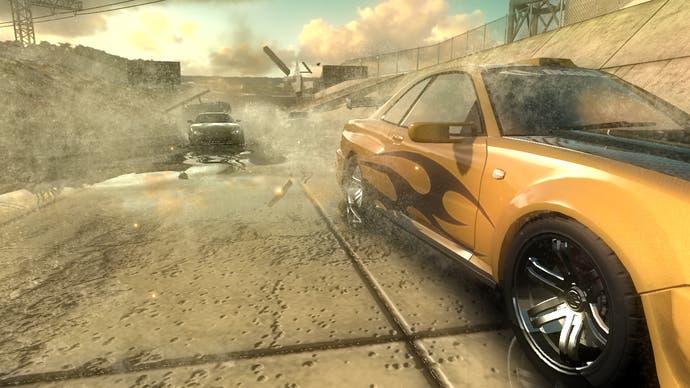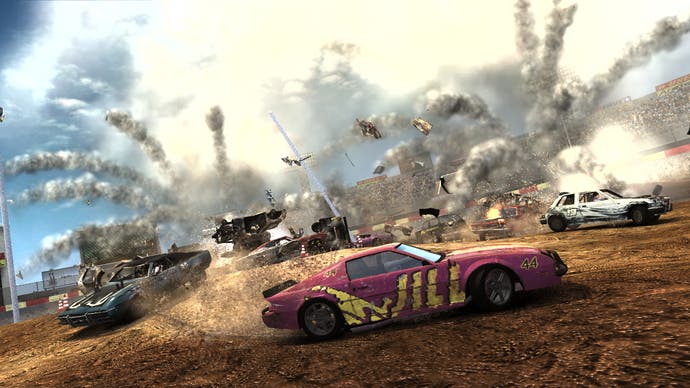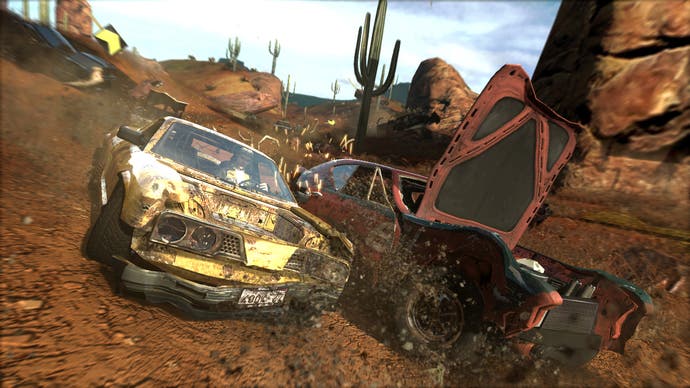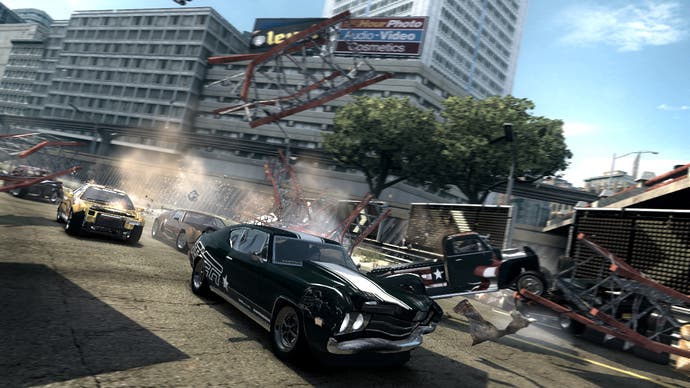FlatOut Ultimate Carnage
Harness your road rage.
I don't drive. I've had a couple of near-misses with driving, mostly interrupted by moving to a car-unfriendly metropolis in the nick of time, but the bottom line is: I don't drive.
On the moments when I slam down the accelerator and hurtle around a corner with a scream of protesting rubber, flinging crates and boxes piled next to the road flying through the air with balletic grace, and catching the side of a rival just so with the sliding, fishtailing back of my car, so that they crunch into a building with a satisfying crunch and a tinkle of shattered glass... On those moments, I wonder if it's just as well that I don't drive.
I remember all too well the friend who couldn't understand his driving instructor's abject horror at his flagrant abuse of the handbrake - what else is it there for, after all, if not to assist cornering? Was this man seriously trying to suggest that videogames had lied to us about how cars are driven? Preposterous!
By that standard, FlatOut Ultimate Carnage is a vast, epic, whopper of a lie. It's an astonishing untruth, a fake reflection of a world in which going FlatOut will almost certainly earn you a speeding ticket and Ultimate Carnage is most likely to involve a combine harvester, a school bus and a foggy morning. Like all good lies, it straddles two worlds; it's just true enough to be believable, and simultaneously false enough to be alluring.
On a more basic level, it's also shaping up to be a really bloody good game where you get to smash things up with cars. Huzzah!
Buckle Up

The FlatOut series might not be one you're familiar with - but that's more a reflection of the power of EA's marketing for the likes of Need for Speed and Burnout than it is of FlatOut's quality. Plucky London-based publisher Empire may not be able to match EA's spend, but anyone who's played either of the last two FlatOut games can attest to the talents of the development boys at Bugbear Interactive.
People who have played FlatOut are FlatOut fans - and that includes Eurogamer, I might add. Pat called the first instalment of the series "a hair's breadth from being legendary", while Dan Whitehead granted the sequel a damn respectable eight points out of a possible ten. That's our scoring scale at Eurogamer - you're probably familiar with it. So, while the series isn't exactly standing shoulder to shoulder on the podium with Burnout or Need for Speed, we're still pretty hot on the idea of a next-gen implementation of Bugbear's metal-twisting, rubber-burning, gearbox-grinding smash-'em-up.
Which, perhaps, makes our first glimpse at the game all the more disappointing - because much as FlatOut 2 was largely speaking a tweaked and updated version of the original game, this is, at heart, a tweaked and updated version of FlatOut 2. Whereas titles like Need for Speed tend to evolve and change significantly between versions, FlatOut seems to have followed Ridge Racer's model instead; the graphics, handling and gameplay have received updates, but many of the core elements of the game - including some tracks - remain broadly the same.

That, as noted, was our first impression - "hey, this is just a high-definition port!" - but faith has been more than restored by a little more playtime with the preview version of the game. Sometimes, not fixing what isn't broken is the right approach, after all.
FlatOut's basics weren't broken; the bulk of the tracks, the basics of the gameplay, were exactly what you would want from a high-octane, exceptionally destructive racing game. So instead of innovating for the sake of innovation, Bugbear has spent its time - and the significant resources of the Xbox 360, for which the game is a platform-exclusive - on adding more and more to the game. So far, at least, it's a better game for it.
"More" is a keyword here. The first thing old-hands at the series will notice (and for those who are newcomers to the series, to whom concerns about rehashed tracks won't matter a damn, the whole thing will be a treat) is that there are four more cars on the track with you - a total of 12 cars per race, compared to eight in FlatOut 2. It's a good addition; it makes races more intense, competition more fierce, crashes more satisfying.
A similar "more" is the addition of vastly, vastly more track-side objects to interact with - where by "interact" I mean "smash into and break into smithereens, or send flying across the track". We're told that there are between five and eight thousand objects on each track, and it's not hard to believe; once the cars have been around a circuit and done some damage, it looks like the aftermath of a whirlwind in a supermarket. The objects aren't just meaningless trash, either; some of them are weighty enough to affect the handling of your car, which can seriously change how races turn out.
Less is More? As if.

What else is "more"? Well, more polygons, unsurprisingly, and more detail in the textures - which does really show through. Everything looks crisp, sharp and shiny, cars are delightfully detailed, and the damage taken by cars (which is lovingly rendered in a whole lot of different ways, rather than just being demonstrated by unchanging buckled-bonnet damage models) looks gorgeous, in a scrapheap sort of way. As you'd expect from an Xbox 360 game, visual effects like high dynamic range (HDR) lighting are thrown around like candyfloss tossed by an insane clown.
Graphically, the game doesn't quite stand up alongside the likes of Gran Turismo HD or Project Gotham Racing 3, but it's not trying to; it's faster, nastier, and more full of flying objects, smashing glass, fizzing sparks and choking smoke. In stills, it doesn't look that amazing, but when you see how much is going on on-screen at once, it starts to feel like the game lives up to its billing of Ultimate Carnage.
In terms of game modes, FlatOut Ultimate Carnage offers just about what you'd expect; Time Trials, a Career mode for progressing through the stages of the game, Stunt Challenge mode, and a new addition to the series called Carnage, which is a throwback to Destruction Derby and simply invites you to cause a massive mess. The game also remembers its roots - the first FlatOut was widely loved for its vastly over-the-top ragdoll animations, where drivers would be flung out of the car during spectacular crashes. FlatOut Ultimate Carnage retains a number of mini-games which make you crash in specific ways to fling drivers at targets and so on, which look like being excellent, wince-inducing fun.
Of course, no Xbox 360 game would be complete without a healthy dollop of Xbox Live on top of the action, and Bugbear looks set to deliver on this point. We haven't had a chance to try out the online multiplayer in the game (as is often the case with preview code), but it looks like eight-player online races will be joined by a reworking of the stunt mode suitable for multiplayer, along with a number of multiplayer-only modes, including the intriguingly named Head-On.

Being preview code, the version we've played with has a number of issues - chief among them being the handling, which seemed to wrench control of our vehicle out from under us at the slightest provocation, turning our carefully calculated powerslides into jarring crashes. A little tweaking is needed here (although this was also a problem with the first two games, so hopefully the developer will have taken note for this instalment); the game is happy to dispense with real physics in the name of fun most of the time, and tweaking the unforgiving handling would definitely be a step in the right direction.
However, despite this niggle - and a certain level of concern over just how much content is going to be recycled from FlatOut 2 - we're definitely liking what Bugbear has done with the place. It looks great, there's loads more stuff to smash... What more could we ask? While accusations of being Burnout's redneck cousin probably won't be allayed by the proudly downmarket presentation, our hands-on time suggests that the game ticks the box marked "fun" with a big, wavy, squealy line of burnt rubber.
We'll be looking forward to casting a critical eye over the final code as we get closer to the game's launch at the end of June.


